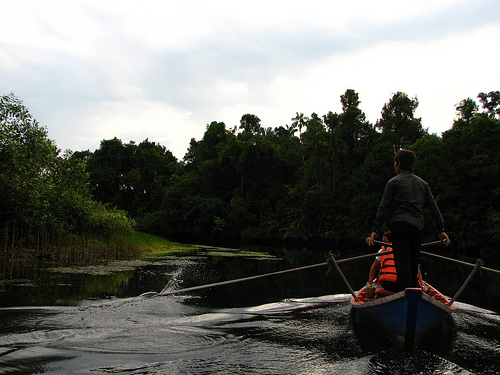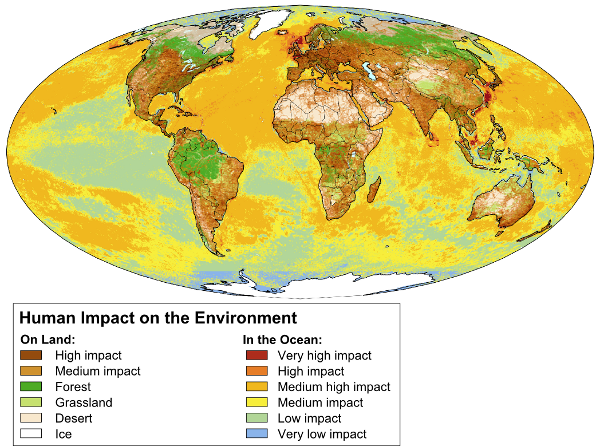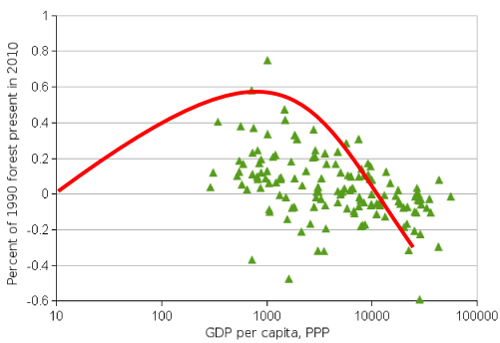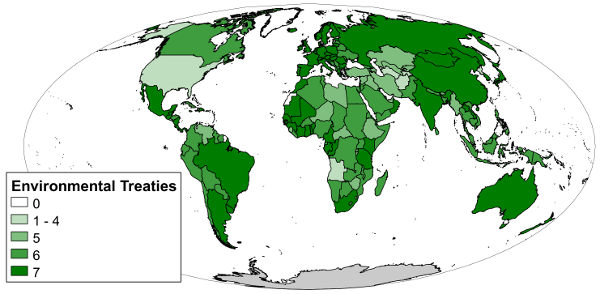Sustainable Development

Residents of Chi Phat village in Cambodia have embraced ecotourism as a path to sustainable development. Ecotourism is increasingly popular, as it seems to offer a way to generate income within the existing capitalist system, without using up or destroying natural resources.
photo from Flickr/MsNina
Measuring our Impact [link]

Figure 1: Human impacts on the environment. Note that land and ocean areas have different legends because this data was taken from two different sources.
data from United Nations Environment Programme: Land, Ocean
If human activity has the potential to affect the environment in unsustainable ways, it would be useful to have a way to conceptualize how big that impact is (Figure 1). This is commonly done through the framework known as "IPAT" (Chertow 2001). IPAT, sometimes written I=PAT, is an acronym for the following equation:
Impact = Population x Affluence x Technology
In the IPAT framework, the impact of human activities on the environment is a function of three variables. Population refers to the number of people present. If there are more people, all else being equal, there will be higher withdrawal of resources, higher usage of sinks, and thus greater impact on the environment. Affluence here refers to the average per-capita level of material wealth that people have. All else being equal, a society in which people have more material wealth will have a greater impact on the environment. Finally, technology refers to the efficiency with which resources are converted into wealth. The more efficiently we can use our resources, the smaller our environmental impact. Though IPAT is a useful conceptual model, it has been difficult to operationalize in precise mathematical terms, leading to some analyses that suggest population is the main driver of contemporary environmental impacts (Daily and Ehrlich 1992), while others conclude it is affluence or technology that makes a bigger difference (Commoner 1971).
Note that IPAT measures the total impact within a closed system based on averages of affluence and technological efficiency. This tends to obscure two issues that geographers find very important. First, there may be big differences in who is responsible for more of the total impact. The debate over whether population or affluence is more significant can be highly politicized, as emphasizing affluence blames rich residents of the First World for most of the total impact, whereas emphasizing population seems to blame poor residents of the Third World. Second, there may be important variations in where the impact is occurring -- for example, use of chlorofluorocarbons all around the world produced an ozone hole that mostly affected areas close to the Antarctic.
One popular way to evaluate an individual's personal contribution to environmental impacts is to calculate their ecological footprint (Wackernagel and Rees 1996). A person's ecological footprint is a measurement of the amount of resources, sinks, and services that are necessary to maintain that person's lifestyle. Typically, footprint calculations are done either for one resource or sink at a time (e.g. your "carbon footprint" measuring the amount of CO2 emissions you are responsible for), or they convert all of the resources and sinks into a common denominator of average land area (leading to statements like "we would need 4 Earths if everyone in the world lived your lifestyle"). Average ecological footprints for most countries can be seen in Figure 2. Note that there remains much controversy over the precise calculations for ecological footprints, and different methods can come up with surprisingly different results. What is important for the purposes of this chapter is the concept, rather than the precise measurement of it.
The size of a person's ecological footprint depends on both their personal habits and the social structure they inhabit. For example, some footprint analyses have calculated that Buddhist monks (known for their frugal living) in the US still have higher ecological footprints than the average person living in some less-developed countries (MIT 2008). The economic system and physical infrastructure (houses etc) that exist in the US simply make it difficult to achieve even basic day-to-day necessities without imposing a significant impact on the environment. On the other hand, the monks in question certainly have a much smaller footprint than, say, a businessperson who eats steak every day and frequently takes cross-country flights.
The physical location of the activities included in a person's ecological footprint may be dispersed around the world. Indeed, in many cases the environments of countries in the global economic core have been cleaned up by simply displacing dirty industries and dangerous wastes to the periphery (Gbadegesin 2001, Jorgenson et al. 2010). This means that the impacts of a person's footprint may be borne by other people. Understanding which people will bear which impacts depends on the nature of the resource or sink in question, the power differences between people along various axes of inequality, and the structure of the national and international economies.
Sustainable Development [link]
If affluence increases the human impact on the environment, we have a prima facie reason to worry that the process of development might lead to unsustainable resource use. On the other hand, if improved technology reduces our impact on the environment, then perhaps development would increase the sustainability of resource use.
In 1987, the United Nations convened a group of leaders and scientists to investigate how development related to sustainability. The group's final report, commonly called the "Brundtland Report" (after conference chair and former Norwegian Prime Minister Gro Harlem Brundtland), defined the concept of "sustainable development" as (World Commission on Environment and Development 1987):
Sustainable development is development that meets the needs of the present without compromising the ability of future generations to meet their own needs. It contains within it two key concepts:
- the concept of 'needs', in particular the essential needs of the world's poor, to which overriding priority should be given; and
- the idea of limitations imposed by the state of technology and social organization on the environment's ability to meet present and future needs.
The Brundtland Report concluded that poverty was as likely to be a cause of environmental degradation as wealth. The poor are pushed to exploit fragile environments in order to survive, creating environmental destruction out of proportion to the prosperity they derive from it. For example, poor farmers can't afford to implement soil conservation measures, so they overexploit the soil in the short term. Furthermore, the Brundtland report pointed out that environmental degradation would undermine development. Without a sustainable resource base, the increasing material prosperity that defines development would not be able to continue. Thus the report called for a combination of expanded trade and aid to combat poverty in poor countries as a major way to create sustainable development.

Figure 3: Deforestation in the Amazon basin. There has been much debate over whether Amazon deforestation has been driven primarily by poor people forced to slash and burn the forest in order to eke out a living, or by large pastoral and logging operations producing for urban and international markets.
data from Landsat
The Brundtland report's conclusions have become conventional wisdom among many people working in the field of development and global environmental change, but there have also been many critics challenging the idea that the poor are primarily responsible for environmental destruction. The practices of the poor, they argue, are often quite sustainable and draw on extensive TEK. Instead, it is the encroachment of large capitalist companies that creates the greatest environmental degradation, even in the poorer parts of the world (Jarosz 1996). Empirical studies have found both poverty-driven and big-company-driven degradation (or both operating together) in different parts of the world (Geist and Lambin 2001).
Can Capitalism Be Sustainable? [link]
Sustainable development has become a powerful buzzword in the decades since the Brundtland Report, because it seems to unite two appealing goals of increasing prosperity and increasing protection of nature. However, there has been much debate over whether sustainable development is actually possible. The starting point for this debate is that since the fall of the Soviet Union in 1991, the only models of development on the table have been capitalist ones. Capitalism is an economic system involving private ownership of capital (money, machinery and tools, and resources), wage labor, and profit-driven competition between buyers and sellers in the marketplace. Policies aiming to promote sustainable development have generally worked within the capitalist system, attempting to redirect capitalist resource use and waste production to put less pressure on the environment. Optimists about capitalist sustainable development argue that a well-functioning free market can make sustainability profitable. Pessimists hold that the only way to create a sustainable society is to reject the capitalist system entirely. The alternatives envisioned by these pessimists are usually inspired by small-scale traditional societies, rather than the Soviet model of large-scale industrial command economy. The latter proved to be as destructive to the environment as capitalism -- if not even more so.
The environmental problems generated by capitalism are usually attributed to externalities. Externalities are costs or benefits of an activity that are not borne by the person responsible for the activity. In our chapter on economic geography we discussed the role of positive externalities in creating industrial agglomerations. In the environmental case, most of the relevant externalities are negative ones. A person or company is able to fob off the costs of their activity on someone else, thus making their product cheaper than it otherwise would be. Regulations often aim to internalize the environmental costs of production. That is, the regulations aim to make producers pay their fair share for the damage they do to the environment. If a factory can dump its waste in a stream, it does not have to pay for the damage it does to the environment. If, on the other hand, the company has to pay for waste disposal, that cost will be factored into its decision about how and how much to produce. There will now be an incentive to either raise the price (encouraging consumers to buy less of the product, and thus reducing the overall damage to the environment), or to find a less environmentally damaging and hence cheaper way to produce it. Optimists about the sustainability of capitalism often argue that if we could internalize most environmental externalities, then the market mechanism will automatically drive our economy toward more sustainable production (Anderson and Leal 2001).

Figure 4: Deforestation and the Environmental Kuznets Curve. Statistics on deforestation rates show declining rates of deforestation -- and even a transition to re-forestation -- as countries become richer. This is consistent with the predictions of the theoretical environmental Kuznets curve (in red).
data from World Bank
Optimists about the sustainability of capitalism often point to the idea of the environmental Kuznets curve. The environmental Kuznets curve -- named for economist Simon Kuznets, who discovered a similar curve with respect to inequality -- is a phenomenon sometimes found when we graph the relationship between environmental degradation and wealth (Rudel et al 2005). Figure 4 gives one example, in the case of deforestation. In the poorest countries, there is not enough technology or economic activity to have a significant impact on the environment. As the country's economy grows, degradation increases as people demand more material goods and have improved means to exploit the environment. But when we reach the richest countries, we see the level of environmental impact declining. Rich countries now have the money to pay for environmental protection. Moreover, people whose basic material needs have been met go on to demand "postmaterial" goods like clean air and the satisfaction of knowing endangered species are being saved (Inglehart and Baker 2000).
The theory of the environmental Kuznets curve is not without its critics (Mills and Waite 2009). After all, the rich countries still have the largest environmental footprints. The environmental Kuznets curve is based on environmental conditions within the country -- but in a global economy, the resources used by a country and the sinks their waste go into may be located anywhere around the world. In essence, these critics argue, core countries are able to protect their own environments by displacing environmentally damaging activities to the semiperiphery (the up-and-coming countries in the middle of the environmental Kuznets curve, with the highest degradation levels) (Jorgenson et al. 2010).
Claims that capitalism can be made sustainable usually rest on pointing to improved technology produced by capitalism-driven innovation. If we can improve technology sufficiently, we can achieve the same level of affluence without using up as many resources or filling up as many sinks. One pessimistic rebuttal to this idea is the Jevons Paradox (Alcott 2005). The Jevons Paradox, also known as the rebound effect, holds that as technology improves environmental efficiency, the gains will just be eaten up by increased exploitation of the environment. For example, imagine that with existing technology we could generate a million kilowatt-hours of electricity from a thousand tons of coal, producing 500 tons of carbon dioxide emissions. If we then invent a new type of power plant with twice the efficiency, we could generate the same amount of electricity from only 500 tons of coal, and generate only 250 tons of carbon dioxide. However, the improved efficiency of the new coal power plants will cause the price of electricity to drop, encouraging people to use more of it. We could then easily see a situation in which people end up demanding two million kilowatt-hours of electricity, meaning that the same 1000 tons of coal will be used up, and the same 500 tons of carbon dioxide will be released. The Jevons Paradox points us toward a more general point: the capitalist market is good at finding the most efficient way to use resources, but does not have any way to set an overall limit on the scale of resource use (Daly and Cobb 1989). The market will use up as many resources as it can, and then use them to produce as much as it can from them.
The Jevons Paradox is based on abstract economic modeling. Thus, it is an empirical question whether it actually applies to any given situation. In the real world there are many other factors that influence how much more of one resource people will use if its price drops. The results of empirical studies have shown that the rebound for different resources can vary widely (Sorrell 2007).
Another question about the sustainability of capitalism surrounds the issue of green consumerism. Green consumerism is the idea that consumers will be motivated to purchase products that are more sustainable, thus making sustainability profitable. Green consumerism has become a major business in the last few decades. It is difficult to estimate the size of the "green" market because of ambiguity about what products count as green. Sales of organic foods, one of the better known green market segments, make up 4% of all US food and beverage sales, and are rising by up to 20% per year (Organic Trade Association 2011).
One of the pitfalls of green consumerism is that making sustainability profitable depends on consumers being able to reliably distinguish between more sustainable and less sustainable products. It's easy enough for a consumer to tell the difference between margarine that tastes good and margarine that tastes bad. But it's much more difficult for a consumer to choose between margarine made from sustainably-grown palm oil versus margarine made from palm oil from destroyed orangutan habitat. The consumer has to rely on information conveyed by the product package, or go out of their way to seek out third-party advice. Manufacturers have seen the potential to reap higher profits from products perceived as sustainably-produced. But in many cases it's cheaper and easier to convince consumers that an existing product is sustainable than to actually make sustainabiliy-enhancing changes to the production process. This practice of putting green labels on products that are not particularly friendly toward the environment is called greenwashing.
Certification systems exist to try to convey reliable information to consumers and prevent greenwashing. These certification systems are not without problems, however. On one hand, there are controversies about how to define the certification requirements. For example, when the US Department of Agriculture put out its new rules for certifying organic foods, many organic farming activists complained that the standards were too lax, allowing products with significant non-organic ingredients to get the label (Kindy and Layton 2009). On the other hand, the procedure for getting certification can be onerous for small producers, especially if the rules were written with large operations in mind. Thus for example many coffee growers whose practices are organic are not able to get organic certifications -- and thus not able to reap the increased profits of selling organic products -- because they cannot afford the testing and documentation necessary (Mutersbaugh 2002).
A final worry about the sustainability of capitalism is the idea of a race to the bottom. In a globalized economy, businesses have a great deal of freedom to move to whatever location they like. Because of the competition for profit, companies would usually prefer (all else being equal) to operate in a place that has lower environmental regulations. This means that if one state or country imposes a regulation to stop an environmentally degrading practice, companies will be motivated to move to a different state or country. Such a loss of business would be detrimental to the regulating country. Moreover, the environmental degradation produced in the second country can still affect the regulating country -- e.g. pollution dumped into the Rio Grande from the Mexican side of the border will hurt people and ecosystems on the US side.
Empirical evidence for a race to the bottom is scant (Drezner 2006). While businesses may complain loudly about the burden of regulation, the costs of compliance are usually not great enough to outweigh other factors that influence a business's choice of location. Nevertheless, the idea of a race to the bottom is prominent in political rhetoric. It is used both by advocates of lower environmental regulation as well as by advocates of restrictions on free trade.
International Environmental Agreements [link]

Figure 5: Ratification of major international environmental agreements. There are hundreds of international environmental agreements. This map shows the status of seven major ones: Basel Convention on the Control of Transboundary Movements of Hazardous Wastes and Their Disposal, Convention on Biodiversity, Convention on International Trade in Endangered Species of Wild Fauna and Flora, Kyoto Protocol to the United Nations Framework Convention on Climate Change, International Convention for the Regulation of Whaling, Montreal Protocol on Substances that Deplete the Ozone Layer, and United Nations Convention on the Law of the Sea.
data from Basel Convention, Convention on Biodiversity, CITES, Kyoto Protocol, IWC, Montreal Protocol, UNCLOS
Efforts to prevent a race to the bottom and to overcome a tragedy of the commons with respect to global and regional scale environmental problems have led to many international environmental agreements. Some of these are regional in focus, such as the Barcelona Convention for Protecting against Pollution in the Mediterranean Sea. Others aim to create consistent environmental standards around the entire world. Figure 5 shows the number of countries who have ratified seven of the most notable international agreements.
Creating effective international agreements can be a difficult process. A treaty, even if established under the auspices of the United Nations, can be freely rejected by any country who chooses to. Thus treaties are often written to the lowest common denominator in order to encourage wider buy-in. The original version of the International Convention for the Regulation of Whaling set such high whaling quotas that it barely had any conservation effect -- though shifts in public opinion against whaling later made it possible to tighten the quotas into a near-ban on whaling. Enforcement mechanisms for countries violating their commitments under a treaty are typically weak or even nonexistent, and may depend heavily on the geopolitical power of the disputants. For example, it is widely understood that Japan is exploiting a loophole in the whaling convention to be able to continue some commerical whaling, but the International Whaling Commission has been unable to take action to put a stop to it (though Japan has also been unable to get the IWC to change its rules to explicitly allow commercial whaling).
The difficult dynamics of international environmental agreements can be illustrated by contrasting the Montreal Protocol on Susbtances that Deplete the Ozone Layer and the Kyoto Protocol to the United Nations Framework Convention on Climate Change (Sell 1996). The Montreal Protocol is widely considered one of the most successful international environmental agreements. The protocol led to the phasing out of ozone-depleting chemicals in the 1990s. The "hole" in the ozone layer reached its largest size in 2006, and has been healing ever since, with scientists projecting that it would return to normal by 2050. The effects of ozone depletion were most severe for high-latitude countries, such as those in Europe and North America. These countries were also the main producers and users of ozone-depleting substances. Thus, the countries whose compliance was most necessary to make the treaty work were also those with the greatest self-interested motivation to sign on. (Nevertheless, some countries were still reluctant to fully phase out ozone-depleting substances -- for example, the United States insists on continuing to use the agricultural pesticide methyl bromide.)
The incentives are aligned rather differently in the case of the Kyoto Protocol. This also involves a global atmospheric problem. Nevertheless, the incentives for member countries are different. The largest contributors to the problem are the same richer countries that were the principal contributors to the ozone depletion problem. However, the worst effects of climate change are likely to be felt by poorer, tropical, and small island countries. Efforts were made to write the treaty to try to gain the acceptance of certain key countries, particularly the skeptical US and Australian negotiators, but Australia did not ratify it until 10 years later, and the US has yet to ratify it.
Works Cited [link]
Alcott, Blake. 2005. Jevons' paradox. Ecological Economics 54 (1): 9–21.
Anderson, Terry Lee, and Donald Leal. 2001. Free Market Environmentalism. New York: Palgrave.
Chertow, Marian R., 2001. The IPAT equation and its variants; changing views of technology and environmental impact. Journal of Industrial Ecology 4 (4): 13-29.
Commoner, Barry. 1971. The Closing Circle: Nature, Man, and Technology. New York: Bantam Books.
Daily, Gretchen C., and Paul R. Ehrlich. 1992. Population, sustainability, and earth's carrying capacity. BioScience 42 (10): 761-732.
Drezner, Daniel W. 2006. The race to the bottom hypothesis: an empirical and theoretical review.
Gbadegesin, Segun. 2001. Multinational corporations, developed nations, and environmental racism: toxic waste, exploration, and eco-catastrophe. In Faces of Environmental Racism: Confronting Issues of Global Justice, eds. Laura Westra and Bill E. Lawson, 187-202. Lanham, MD: Rowman and Littlefield.
Geist, Helmut J., and Eric F. Lambin. 2001. What Drives Tropical Deforestation? A Meta-Analysis of Proximate and Underlying Causes of Deforestation Based on Subnational Case Study Evidence. Louvain-la-Neuve: LUCC International Project Office.
Inglehart, Ronald, and Wayne E. Baker. 2000. Modernization, cultural change, and the persistence of traditional values. American Sociological Review 65 (1): 19-51.
Jarosz, Lucy. 1996. Defining deforestation in Madagascar. In Liberation Ecologies: Environment, Development, Social movements, ed. R. Peet and M. Watts, p. 148-164. London: Routledge.
Jorgenson, Andrew K., Christopher Dick, and Kelly Austin. 2010. The vertical flow of primary sector exports and deforestation in less-developed countries: a test of ecologically unequal exchange theory. Society and Natural Resources 23 (9):888–897.
Kindy, Kimberly and Lyndsey Layton. 2009. Integrity of federal "organic" label questioned. Washington Post, July 3.
Massachusetts Institute of Technology. 2008. Carbon footprint of best conserving Americans is still double global average. ScienceDaily, August 17.
Mills, Julianne H., and Thomas A. Waite. 2009. Economic prosperity, biodiversity conservation, and the environmental Kuznets curve. Ecological Economics 68 (7): 2087–2095.
Mutersbaugh, Tim. 2002. The number is the beast: a political economy of organic coffee certification and producer unionism. Environment and Planning A 34: 1165-1184.
Organic Trade Association. 2011. Industry Statistics and Projected Growth.
Sell, Susan. 1996. North-South environmental bargaining: ozone, climate change, and biodiversity. Global Governance 2: 97-118.
Sorrell, Steve. 2007. The rebound effect: An assessment of the evidence for economy-wide energy savings from improved energy efficiency. London: UK Energy Research Centre.
Daly, Herman E., and John B. Cobb. 1989. For the Common Good: Redirecting the Economy Toward Community, the Environment, and a Sustainable Future. Boston: Beacon Press.
Wackernagel, M. and W. Rees. 1996. Our Ecological Footprint: Reducing Human Impact on the Earth. Gabriola Island, BC: New Society Publishers.
World Commission on Environment and Development 1987. Our Common Future. New York: Oxford University Press.
